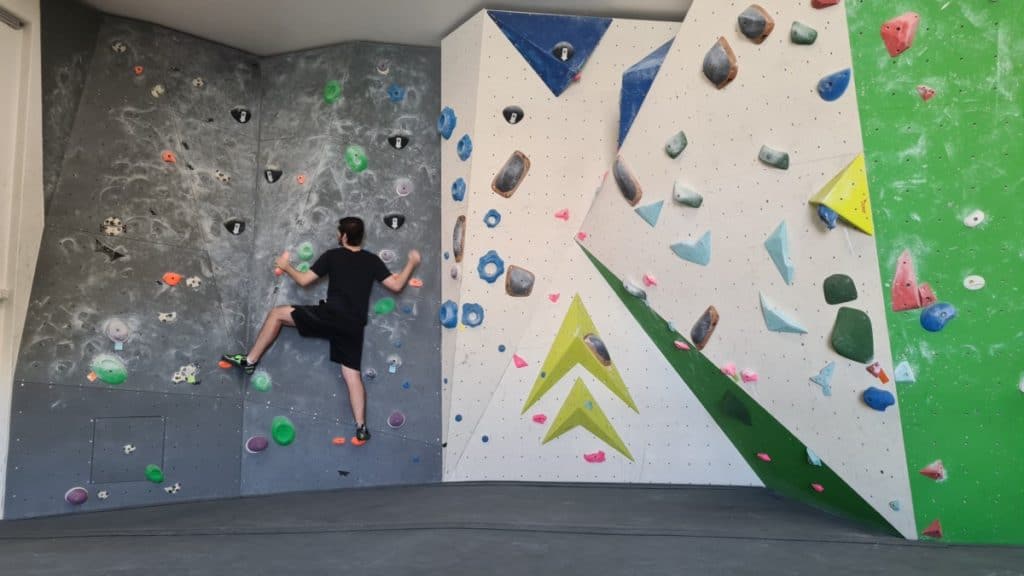
When I started climbing back in 2018 I was only able to climb for 1 hour and was completely exhausted after it. I always asked myself, if this is enough to progress. Now after years of climbing experience I have way more endurance and know how long a climbing session should be to make progress fast and effective.
A climbing session should last between 1 and 3 hours, depending on the skill level of the climber and the intensity of the training. In general a beginner should aim for 60 to 90 minutes, while an advanced climber should be able to climb for 2-3 hours.
There are also many other factors, like the training volume and the duration of the breaks you take, that heavily impact the time how long your climbing session should last. Under the following subheadings I covered all factors that are important for the length of your climbing session.
Intensity and Volume of Your Climbing Training
You can control the intensity of your climbing session by climbing routes or boulders that are easier or harder for you. The easier the route is, the less energy you need to climb it. As you can imagine, if you only climb routes that take little to no effort you could do that for hours and won’t be exhausted.
However the question is, what’s the optimal balance of hard and easy boulders in order to make the biggest progress. To answer this question you should be honest to yourself and categorize yourself as an beginner, intermediate or advanced climber.
As already mentioned above for a beginner climber 1 hour is a good time for a climbing session. So try to choose climbing routes of a difficulty that make you feel exhausted, but still comfortable, after 60-90 minutes. This way you will get a good training and make progress.
The same principle applies to intermediate climbers, that should aim for 1-2 hours and advanced climbers (2-3 hours). The great thing about this stragety is that humans really like to do hard things, that are just doable. So it shouldn’t be too easy (it would be boring), but also not too difficult (it would be overwhelming). If you find the right balance of difficulty, climbing will be very enjoyable for you.
| Skill level of climber | Recommended duration of climbing session |
| Beginner | 1-1.5 hours |
| Intermediate | 1-2 hours |
| Advanced | 2-3 hours |
The volume of your training describes how often you train and how intense. Since you already know how to control the intensity of your climbing session, the question is how often you should climb and how long you should rest. This again depends on how advanced you are in climbing, which is why I wrote a complete post about how many days you should rest between climbing sessions.
If your training volume is high, your climbing sessions will obviously be shorter. Try to adjust your training volume to the time you want your climbing session to be, not the other way around. This is benefitial, because when you always train for about the same period of time you can slowly increase it and see your progress visually in the length of your climbing sessions.

Differences for Beginners and Advanced Climbers in Training Duration
As I have already recommended a climbing session length of 60-90 minutes for beginners and 2-3 hours for advanced climbers, I want to show you why beginners climb easier routes or boulders than more experienced climbers and still should train less.
Advanced climbers can take on harder and higher difficulty routes, because they have developed way more climbing specific strength and endurance compared to the average beginner. Those achieved skills make it possible for them to climb longer and harder.
You could argue, that people that are regularly in the gym and do basic strength or endurance training and now want to start climbing should have a big advantage considered to other beginners, that don’t train at all. There is for sure some kind of advantage, but it is not as big as expected, because the strength and endurance you need for climbing is very specific.
In climbing the fingers and forearms are heavily involved, which are muscle groups that are commonly not trained at all. Especially grip strength is something that many people have to build over time. So don’t try to climb for longer than 2 hours as a beginner, because the time your body needs to recover is so long, that it won’t be optimal and you need a very long resting period between the next climbing session.
Warm-Up and Break Duration in Your Climbing Session
The warm-up isn’t part of the climbing session, altough it’s also time you spend at the gym or outdoors, in case you rock climb in the nature. Don’t skip to warm-up before seriously starting to climb, as warming up properly will prevent many injuries and can even improve your climbing progress. If you want to know how you include your warm-up in your climbing session click here.
In contrast, the break duration you take during the different routes or boulders you climb is part of the climbing session. Taking short and few breaks will make you exhausted very fast, while long and many breaks will keep you energized and your body can recover in the breaks for the next climb.
Break duration and quantity is like the difficulty of the climbing routes, you have to find a balance. Try to make the breaks, so you have enough power to climb for the recommended time. Usually the break between every climb is 1 or 2 minutes. During one climbing session the time you need to pause will increase naturally, because your body will get more exhausted.
Sometimes, especially in the evenings when the climbing gyms are full, you are also forced to pause longer, because other people might be climbing the route you wanted to. Taking a longer break isn’t bad, aslong as you stay warm. So if the waiting time extends 5 minutes make sure to do a little warm up again.
Protection of Your Skin While Climbing
It can sometimes also happen, that you still have enough power to climb another hour, but the skin on your fingers is starting to get damaged. From my own experience I can just give you the advice to stop climbing as soon as that happens. Once the skin is starting to rip off or blisters are on your fingers, everytime you climb a new route on that day it gets much worse.
Unless you have climbing tape to put on your fingers you should stop your climbing session. If you want to learn how to tape your fingers and deal with skin injuries click here. After your fingers recovered, which mostly only takes 2-4 days, you can start climbing again.
Often this only happens in the beginning and as you climb more often your skin gets thicker. However if you climb excessively much this can also happen to a pro climber from time to time. Take care of yourself and you will be able to climb longer with less injuries.
Final Thoughts
How long a climbing session should be heavily depends on your current progress in climbing, however the most important thing is that you like the thing you do, so just climb as long as you feel comfortable and don’t let anybody tell you that you must climb longer. All time recommendations mentioned are just suggestions to give you some ideas and a helpful structure for your climbing sessions.
